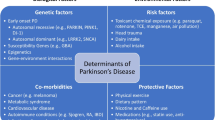Abstract
Familial Adult Myoclonus Epilepsy (FAME), with a prevalence of < 1/35 000, is known under different acronyms. The disease is transmitted in an autosomal dominant manner and is characterized by the occurrence of cortical myoclonic tremor, overt myoclonus, and rare bilateral tonic–clonic seizures. FAME is considered neurodegenerative, although it is relatively slow in progression. Diagnosis is based on specific neurophysiological testing, namely jerk-locked back-averaging, somatosensory evoked potentials, long latency reflex, and motor evoked potentials, among others. Imaging data, including functional magnetic resonance imaging, indicate a cortical origin of the cortical myoclonic tremor and decreased cerebellar activation. Cerebellar changes in Purkinje cells have been noted, from few neuropathology reports, in patients from isolated pedigrees. The differential diagnosis includes essential tremor, some forms of genetic generalized epilepsy, and progressive myoclonus epilepsies. Treatment is mainly symptomatic.
Similar content being viewed by others
References
Cuccurullo C, Striano P, Coppola A (2023) Familial adult myoclonus epilepsy: a non-coding repeat expansion disorder of cerebellar–thalamic–cortical loop. Cells 12(12):1617
van den Ende T, Sharifi S, van der Salm SMA, van Rootselaar AF (2018) Familial cortical myoclonic tremor and epilepsy, an enigmatic disorder: from phenotypes to pathophysiology and genetics. A systematic review. Tremor Other Hyperkinet Mov (N Y), 8:503.
Berkovic SF, Striano P, Tsuji S (2023) History of familial adult myoclonus epilepsy/benign adult familial myoclonic epilepsy around the world. Epilepsia 64:S3–S8
Corbett MA et al (2023) Genetics of familial adult myoclonus epilepsy: From linkage studies to noncoding repeat expansions. Epilepsia 64(Suppl 1):S14–S21
Depienne C et al (2023) Insights into familial adult myoclonus epilepsy pathogenesis: How the same repeat expansion in six unrelated genes may lead to cortical excitability. Epilepsia 64(Suppl 1):S31–S38
Uzun GA, Baykan B (2023) Familial adult myoclonic epilepsy: clinical and genetic approach to an under-recognized disease. Noro Psikiyatr Ars 60(2):174–177
Giraldez BG et al (2023) Familial adult myoclonus epilepsy: Clinical findings, disease course, and comorbidities. Epilepsia 64(Suppl 1):S9–S13
Florian RT, Kraft F, Leitão E, Kaya S, Klebe S, Magnin E et al (2019) Unstable TTTTA/TTTCA expansions in MARCHF6 are associated with familial adult myoclonic epilepsy type 3. Nat Commun 10(1):4919
Pan S, Li X, Li L, Lin H, Wang D, Zhang X et al (2021) Comprehensive genetic, clinical and electrophysiological studies of familial cortical myoclonic tremor with epilepsy 1 highlight the role of gene configurations. Seizure 87:69–74
Depienne C, van den Maagdenberg AMJM, Kühnel T, Ishiura H, Corbett MA, Tsuji S (2023) Insights into familial adult myoclonus epilepsy pathogenesis: How the same repeat expansion in six unrelated genes may lead to cortical excitability. Epilepsia 64:S31–S38
Shibata T, Nagano K, Ueyama M, Ninomiya K, Hirose T, Nagai Y et al (2021) Small molecule targeting r(UGGAA)(n) disrupts RNA foci and alleviates disease phenotype in Drosophila model. Nat Commun 11(12):236
Lagorio I et al (2019) Familial adult myoclonic epilepsy: A new expansion repeats disorder. Seizure 67:73–77
Sharifi S, Aronica E, Koelman JH, Tijssen MA, Van Rootselaar AF (2012) Familial cortical myoclonic tremor with epilepsy and cerebellar changes: description of a new pathology case and review of the literature. Tremor Other Hyperkinet Mov (N Y).
Dubbioso R et al (2023) Familial adult myoclonus epilepsy: Neurophysiological investigations. Epilepsia 64(Suppl 1):S39–S46. https://doi.org/10.1111/epi.17553
Franceschetti S et al (2023) Cortico-muscular coherence and brain networks in familial adult myoclonic epilepsy and progressive myoclonic epilepsy. Clin Neurophysiol 151:74–82
Raffaele D et al (2022) Abnormal sensorimotor cortex and thalamo-cortical networks in familial adult myoclonic epilepsy type 2: pathophysiology and diagnostic implications. Brain Commun. https://doi.org/10.1093/braincomms/fcac037
van Rootselaar A-F, Cocozza S, Aronica E, Striano P (2023) Familial adult myoclonus epilepsy: Neuroimaging and neuropathological findings. Epilepsia 64:S47–S51
Corral-Juan M, Serrano-Munuera C, Rábano A, Cota-González D, Segarra-Roca A, Ispierto L et al (2018) Clinical, genetic and neuropathological characterization of spinocerebellar ataxia type 37. Brain 141(7):1981–1997
Coppola A, Dubbioso R, Cuccurullo C, Licchetta L, Carreno M, Hirsch E et al (2023) Current treatment options for familial adult myoclonus epilepsy. Epilepsia 64:S58–S63
Mahadevan R, Viswanathan N, Shanmugam G, Sankaralingam S, Essaki B, Chelladurai RP (2016) Autosomal dominant cortical tremor, myoclonus, and epilepsy (ADCME) in a unique south Indian community. Epilepsia 57(3):e56–e59
Mir A, Alghamdi A, Alotaibi W, Samreen D, Alotaibi M, Albaradie R et al (2022) A systematic review of the efficacy of perampanel as treatment for myoclonic seizures and symptomatic myoclonus. Epileptic Disord 24(4):633–646
Oi K, Neshige S, Hitomi T, Kobayashi K, Tojima M, Matsuhashi M et al (2019) Low-dose perampanel improves refractory cortical myoclonus by the dispersed and suppressed paroxysmal depolarization shifts in the sensorimotor cortex. Clin Neurophysiol 130(10):1804–1812
Menon R, Baheti NN, Cherian A, Iyer RS (2011) Oxcarbazepine induced worsening of seizures in Jeavons syndrome: Lessons learnt from an interesting presentation. Neurol India 59:70–72
Striano P, Coppola A, Madia F, Pezzella M, Zara F, Striano S (2007) Life-threatening status epilepticus following gabapentin administration in a patient with benign adult familial myoclonic epilepsy. Epilepsia 48(10):1995–1998
Wurster CD, Ludolph AC (2018) Antisense oligonucleotides in neurological disorders. Ther Adv Neurol Disord 11:1756286418776932
Corey DR (2017) Nusinersen, an antisense oligonucleotide drug for spinal muscular atrophy. Nat Neurosci 20(4):497–499
Funding
None.
Author information
Authors and Affiliations
Corresponding author
Ethics declarations
Conflict of interest
The authors declare that they have no conflicts of interest.
Additional information
Publisher's Note
Springer Nature remains neutral with regard to jurisdictional claims in published maps and institutional affiliations.
Supplementary Information
Below is the link to the electronic supplementary material.
Supplementary file1 (MP4 Video 1652 KB)
Rights and permissions
Springer Nature or its licensor (e.g. a society or other partner) holds exclusive rights to this article under a publishing agreement with the author(s) or other rightsholder(s); author self-archiving of the accepted manuscript version of this article is solely governed by the terms of such publishing agreement and applicable law.
About this article
Cite this article
Cherian, A., Divya, K.P. & Krishnan, A.R.S. Familial adult myoclonus epilepsy: a pragmatic approach. Acta Neurol Belg 124, 389–394 (2024). https://doi.org/10.1007/s13760-023-02432-6
Received:
Accepted:
Published:
Issue Date:
DOI: https://doi.org/10.1007/s13760-023-02432-6




